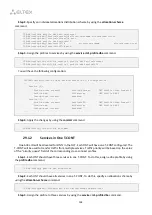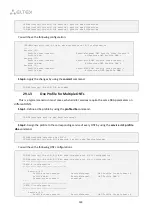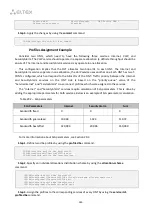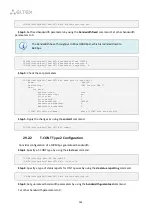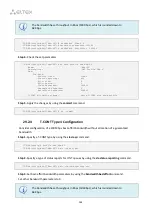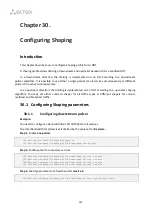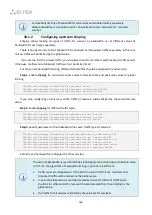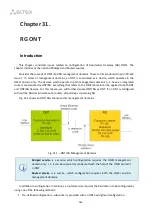
136
Chapter 29.
DBA Configuration
Introduction
This chapter considers DBA configuration for ONT.
GPON technology implies that all ONTs of one GPON channel use common communication
medium (fibre). It is necessary to provide a mechanism that will ensure data transfer from all ONTs
without collisions. The mechanism is called dynamic bandwidth allocation (DBA) and ensures
allocation of time intervals in OLT for data transfer to ONTs.
A logical unit of the DBA algorithm is Alloc-ID (allocation) with a corresponding T-CONT (traffic
counter) on the ONT side. Data transfer parameters (frequency, transmission window) are
separately configured for every Alloc-ID (T-CONT) and are referred to as service level agreement
(SLA).
G.984.3 provides several SLA combinations called T-CONT type. There are the following T-
CONT types:
—
T-CONT type 1 with a fixed bandwidth only. It is suitable for traffic, which is transferred at a
constant speed (or with very low variations) and is sensitive to delays and jitter.
—
T-CONT type 2 with a guaranteed bandwidth only.
This type is suitable for bursty traffic with a well defined upper bound, without strict delay
and jitter restrictions.
—
T-CONT type 3 is a counter with a guaranteed bandwidth and a possibility to allocate a best-
effort bandwidth. This type is suitable for bursty traffic with peak values that requires a
certain throughput to be guaranteed.
—
T-CONT type 4 allows allocation of a best-effort bandwidth without fixed or guaranteed
bandwidths. This type is suitable for bursty traffic with peak values that does not require
any guaranteed throughput.
—
T-CONT type 5 is a counter with fixed and guaranteed bandwidths and a possibility to
allocate a best-effort bandwidth. This type summarises all other types and is suitable for
most types of traffic.
The terminal allows configuration of up to 256 default allocations per channel. When one ONT
is connected, at least one default allocation will be provided. Thus, when 128 subscribers are
connected to a channel, 128 service allocations will be provided. The remaining 128 allocations will
be enough to process data, but not enough to process more than one service in its own allocation.
Summary of Contents for LTP-4X
Page 11: ...11 Part I General ...
Page 29: ...29 Part II Getting Started with the Terminal ...
Page 37: ...37 Part III Configuring the Terminal ...
Page 98: ...98 Part IV ONT Configuration ...
Page 174: ...174 Part V Terminal Monitoring ...
Page 189: ...189 Part VI Terminal Maintenance ...
Page 191: ...191 Step 2 Remove the module from the slot Fig 43 4 Removing SFP Transceivers ...

















